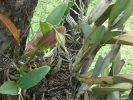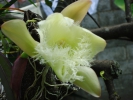|
|
|
|
 |
Email Address Recovery or Password Reset |
Use our Change Password page, and you can set a new password, or if you don't remember which email address you
registered with, the same page may be able to suggest it based on another you enter.
|
|
|
|
|
| |
Flasks of
Rhyncholaelia digbyana 'MC6497' -spontaneous |
|
| |
|
|
| |
| Number: |
TN7702 |
| Name: |
Rhyncholaelia digbyana 'MC6497' -spontaneous
|
| Type: |
spontaneous (What's that?) |
|
Click to Enlarge

Pod Parent Plant |
Click to Enlarge

Pod Parent Flower |
|
|
|
| |
For additional origin/habitat information supplied courtesy of
Charles and Margaret Baker, see further below, near the bottom of this page.
|
Temperatures we attempt to use in the lab & greenhouse:
| For Species: |
|
Spring, Summer, Autumn: days average 88°F, nights 75°F; best fit is Warm 90-70°F
(Source:
Baker's Web OSC) |
| For Species: |
|
Winter: days average 82°F, nights 68°F; best fit is Warm-Intermediate 87-64°F
(Source:
Baker's Web OSC) |
|
About the name...
| Etymology of |
digbyana |
|
Named for St. Vincent Digby, English orchid enthusiast of the 19th century.
(Source:
Mayr & Schmucker 1998) |
| Etymology of |
Rhyncholaelia |
|
From latinized Greek "rhynchos" beak. From the elongated fruit and some similarities to the genus Laelia.
(Source:
Mayr & Schmucker 1998) |
| Pronunciation of |
digbyana |
|
dig-bee-AH-na
(Source:
Hawkes 1978) |
| Pronunciation of |
Rhyncholaelia |
|
rink-oh-LYE-lee-ah
(Source:
Hawkes 1978) |
|
If you would like to direct someone to this web page, please copy and paste this URL into your email:
http://troymeyers.com/d?017702
| Flask Information |
| Availability: |
Seed not viable- failed. We were not able to make any flasks. |
| You should: |
Consider placing a "Notify Retries" Request, and if an identical pollination (the same parents) is done again, we'll let you know. |
|
You might also want to:
|
View the seed assay for this item.
View items of the same species.
View items of the same genus.
|
| Ordering Information |
| You are not currently logged in. |
|
You must be a registered user and be logged in to reserve a flask or place a notification request. Please log in:
|
|
 |
Email Address Recovery or Password Reset |
Use our Change Password page, and you can set a new password, or if you don't remember which email address you
registered with, the same page may be able to suggest it based on another you enter.
|
|
|
|
|
|
|
|
| |
The origin/habitat information below is supplied courtesy of Charles and Margaret Baker
The following information is based on the name of the plant provided by the donor, and assumes that the name is correct. If the plant has been misidentified, then the following information may not be correct.
This text is copyrighted by the Bakers and may not be reproduced without permission.
ORIGIN/HABITAT: Plants are found in the southeastern Mexican states of
Yucatan and Quintana Roo with distribution extending through the
Caribbean-facing lowlands of Belize into Honduras. They grow on stunted
trees in hot, humid lowlands near sea level. There have been some reports
of occurrences in Nicaragua and Guatemala, but we have been unable to
locate any details relating to collections or habitat location in these
areas.
More about this information and the Bakers...
|
|
|
| |
|
|
|